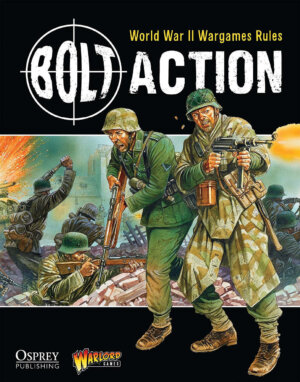
Publishers: Warlord Games and Osprey Publishing
Designers: Rick Priestley and Alessio Cavatore
Year: 2012
Genre: World War Two skirmish level miniatures rules
Players: Two or more
Ages: 12+
Playing Time: Two hours or more
Pages: 216 Pages
MSRP: $35.00 (Hard cover)
Put four World War Two miniatures gamers in a room together and ask them what they look for most in a WWII rules system and you’re more than likely to hear four completely and radically different answers. Some grognards look forward to the strategic options and grand scale of micro armor while others can’t get enough of the small unit tactics found in skirmish level games. One wargamer might want to see every minute and differentiating detail of even the most minor powers simulated on the gaming table while another may gravitate toward rules that keep the action flowing in order to complete a good sized battle in the space of a Saturday afternoon.
Sometimes it seems as if there are as many systems to bring the Second World War to the gaming table as there are gaming tables so why should veteran miniature gamers, or even those looking to get into the hobby, get excited about a new 28mm skirmish rule set like Bolt Action when there are already a slew of systems on the market? Truth be told, two factors of Bolt Action should stand out as reasons to begin considering a serious look at the rules: The involvement of Rick Priestley and Alessio Cavatore as well as drawing from the established line of Warlord Games miniatures. Experienced mini players will instantly recognize Priestly and Cavatore as two of the minds behind the glory years of Warhammer 40k while Warlord Games has established themselves as one of the premiere manufacturers of historical miniatures – I’ll get into more detail about the minis in just a bit. Toss in Osprey Publishing’s involvement in producing the rulebook and we have a product that demanded a closer look.
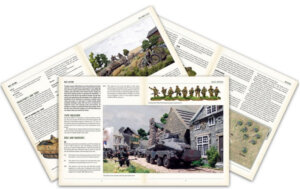
The game is effectively broken into two sections, the rules and the army lists. The rules and scenarios are covered in 112 pages while the force selection portion runs 66 pages. The rules are well written, easy to follow and there weren’t any major typos that jumped out at me. The armies provided in the core book are the Germans, Americans, British, and Soviets. Other major and minor combatants will be covered in future supplements and I’m sure there will be more source books for the included nations as well. Also included in the book are a sample game play through, a timeline of the war, charts, and a few other small sections.
Rather than get into the minutest details of the rules I’ll focus on the core elements as well as my impressions of play. I’ll be the first to admit I’m not the most experienced skirmish level WWII gamer – I always played a lot of micro armor – so my apologies for my lack of knowledge of many of the other systems out there as I can’t make an apples to apples comparison; something may strike me as unique when in reality it may be something found in a lot of skirmish games…
Bolt Action is a very infantry-centric system and one of the more striking features is the fact forces aren’t allowed to toss armor into the mix all willy nilly. If you’re playing a standard 1,000 point game don’t be expecting to field multiple Panzer IVs or Shermans as the recommended breakdown is no more than one heavily armored vehicle, one lighter armored vehicle, and a single artillery piece allotted for every three or four infantry squads. The number of models on the table during a battle also appears to be smaller than what might be found in other games.
Each turn players place a number of dice equal to the number of units in their force into a cup as these will be used to activate units. Obviously each side will use a different color in order to differentiate the sides and when a die is drawn that player may activate one of their units and issue their order for that unit. Once all dice have been drawn a new turn begins and dice for remaining units are returned to the cup.
Six orders are available: Fire, Advance, Run, Ambush, Rally, and Down.
Fire – Simply enough the unit is able to fire their weapons while taking no movement.
Advance – Move and fire with a firing penalty. Infantry moves 6” and vehicles normally move 9”.
Run – Movement without an opportunity to fire. Infantry gets 12” and vehicles for the most part 18”.
Ambush – What normally is referred to as an overwatch. This unit can take opportunity fire at a unit which moves into range.
Rally – Forfeiting movement or firing the unit may attempt to remove D6 pinned markers.
Down – The unit doesn’t move or fire but goes to ground or takes up positions to best utilize cover.
The game mechanics of Bolt Action are focused on moving the action along quickly and everything is based on six sided dice. For the most part combat, casualties, vehicle damage, close assaults, morale and other aspects of game play are simplified to promote fast action resolution. Infantry combat is resolved by rolling a six sided die for each miniature with most assault weapons receiving additional dice at shorter ranges. A roll of three or higher is required to hit with cumulative modifiers added or subtracted to the hit number. Each hit is resolved against the morale level of the target (inexperienced 3+, Regular 4+, and Veteran 5+) and figures are lost if the target number is met or exceeded. If a unit loses 50% or more of its figures a morale roll is made and if the unit fails it’s removed from the table.
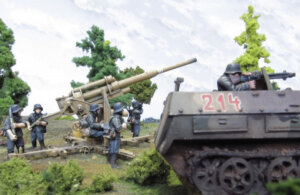
Two interesting mechanics also come into play with the Nigh Impossible Shot and Exceptional Damage. If a target unit is in range but the number to hit is higher than a six, you can still fire as normal and every six you roll can be rerolled and any sixes on these second rolls score hits – thus the Nigh Impossible Shot. With Exceptional Damage for every six rolled for damage you roll those dice once again and for every additional six you may choose a miniature of your choice to score as a casualty.
Close combat plays quick and dirty as units within 12” of an enemy can select a run order to move into hand to hand combat (Bonsai!) although the defender will have a chance to fire at the attackers if they are further than 6” away and the defender has not already activated this turn. If the defender can fire they bring the full force of their weapons to bear and any surviving attackers are moved into contact. The attackers roll to hit, defenders take casualties, the defenders get their rolls, the attacker takes casualties and the unit taking the most casualties is removed. In the case of a tie another round of close combat takes place.
It goes without saying close quarter assaults can swing the tide of battle although careful timing and planning is surely required. The resolution is much simpler than melee combat in many other skirmish games I’ve seen, regardless of genre.
Firing against armored vehicles is fairly simple as well as the target vehicle will have an armor rating while the antitank weapon will have a modifier to a single die roll. If the target armor rating is exceeded on a single die then a damage roll is made on the vehicle damage chart. Vehicles are knocked out on a roll of 4+. If the exact number required to hit is rolled then a minus three modifier is made to the damage table roll. Anti-Tank guns which exceed the needed hit roll by three or more receive two rolls on the damage table.
Morale is represented in the game as well and many a battle will be won or lost based on how well you keep your troops in a fighting frame of mind. Morale applies to infantry and vehicles although it’s obviously more difficult to take a Tiger II out of the fight as opposed to a heavy machine gun crew. As previously mentioned every casualty an infantry unit takes adds a pin marker. These pin markers deduct from the overall morale level of the unit: Inexperienced 7 or less, Regular 8 or less, Veteran 9 or less on a 2d6 roll. Vehicles will take pin markers for heavy weapon hits regardless if they take damage or not. As previously mentioned a failed morale roll in combat will remove the unit from the table but that’s not the only effect of morale. Once a unit has begun to take pinned markers whenever they try to activate a roll against their morale must be made. Each marker adds a cumulative negative one modifier and if the unit succeeds they can perform the order as normal. Failure means the unit performs a Down order and can do nothing else for the turn.
If boxcars are rolled on the morale test then the unit not only fails but one of two results can occur: Friendly Fire, which is not good or Panic, which is equally bad…
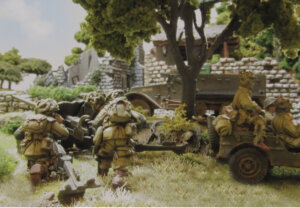
The overall impression one gets playing Bolt Action, especially if they have any experience with 40K, is those two systems have some common mechanics. Granted it’s been years since I played any 40k so the system may have changed radically but I am reminded of a general 40k feel. This isn’t to say Bolt Action is Warhammer WWII but the influence is certainly there – no doubt because of the design team of Priestly and Cavatore. The game plays fast, keeps the action flowing, relies on only a handful of charts, and maintains the focus on fun and quick thinking.
I really like Bolt Action a lot but I can’t say it will appeal to someone who can recite the fire rate of Hitler’s Buzzsaw while following that up with spot on vocal impersonation of its sound. Although each country’s forces have specific abilities, and there are plenty of units modeled in the game, there may not be that extra level of detail and differentiation to appeal to the gamer that’s extremely focused on WWII minis. I know there are many miniature players out there who specifically zero in on tournament play, and although the requisite point values are present for all the units in Bolt Action, my feel of the system is that of everyone having a good time at the table and not necessarily that of kicking someone’s teeth in at all costs. I’m not saying everyone who plays in tournaments have that mindset but you know the type of gamer I’m talking about.
Speaking of costs, one of the great aspects of Bolt Action is the relatively low buy in cost to get started. The rulebook is $35 MSRP and the cost of a standard 1,000 point force will probably run you somewhere in the vicinity of $120-$150, depending on the units you select. This is much friendlier to the wallet than many other systems currently on the market. Plus, figure count runs a bit lower than what I’ve seen elsewhere so this also means getting your troops painted and on the game table a lot quicker not to mention saving on the other supplies needed to get your army looking smart such as paints, flocking, and so forth.
It’s also worth mentioning Warlord has a huge selection of miniatures in the award winning Bolt Action line already. As opposed to the usual experience of picking up a new miniatures rulebook (regardless of the genre) and sitting around patiently waiting for all the cool minis to finally begin production, you already have everything in the core book available for order!
Bolt Action is a welcome addition to the world of skirmish level WWII miniatures. Although it’s target market is more than likely not the grizzled World War Two miniatures veteran, I believe it makes for an excellent introduction to the genre for those who may have shied away from this period due to the complexity of current systems or the high cost of getting started. In other words if you’ve really wanted to get involved in gaming the largest conflict in human history in miniature, but were afraid to make the leap, Bolt Action is fantastic place to start.
[rwp-review id=”0″]
- December Brings the Dreams and Machines: Emerta Valo Setting Guide - Nov 15, 2024
- The Parthenogenesis of Hungry Hollow is Available in Print and PDF - Nov 15, 2024
- Save Big With the Vikingverse RPG Bundle of Holding - Nov 15, 2024




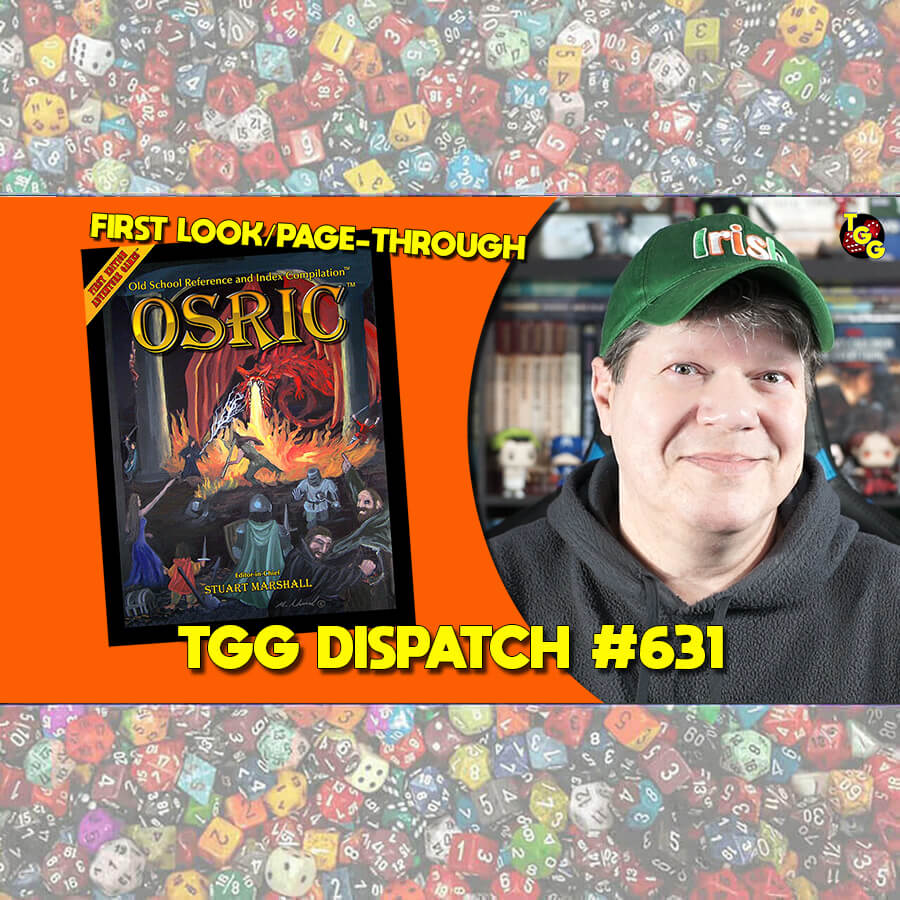


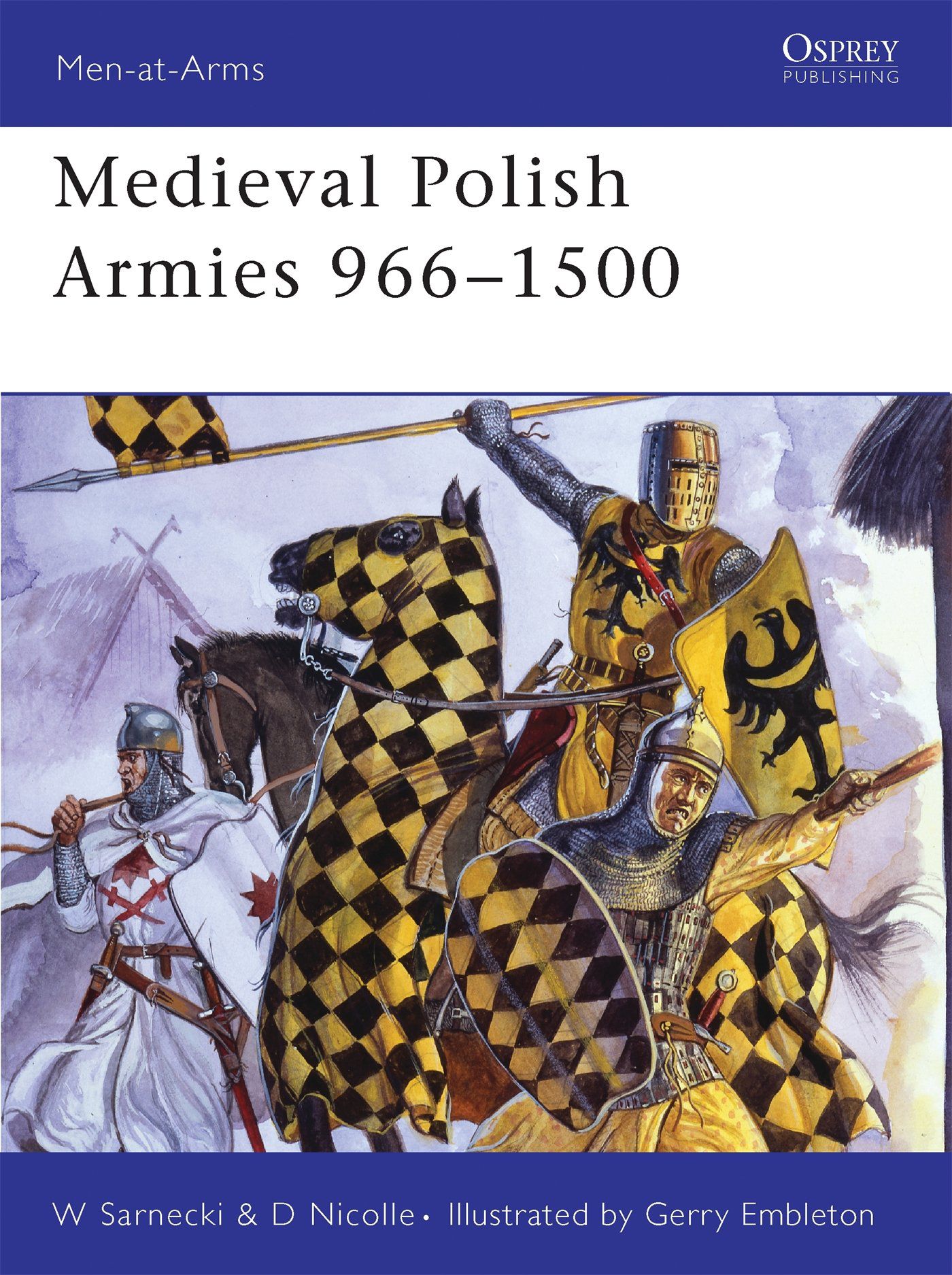

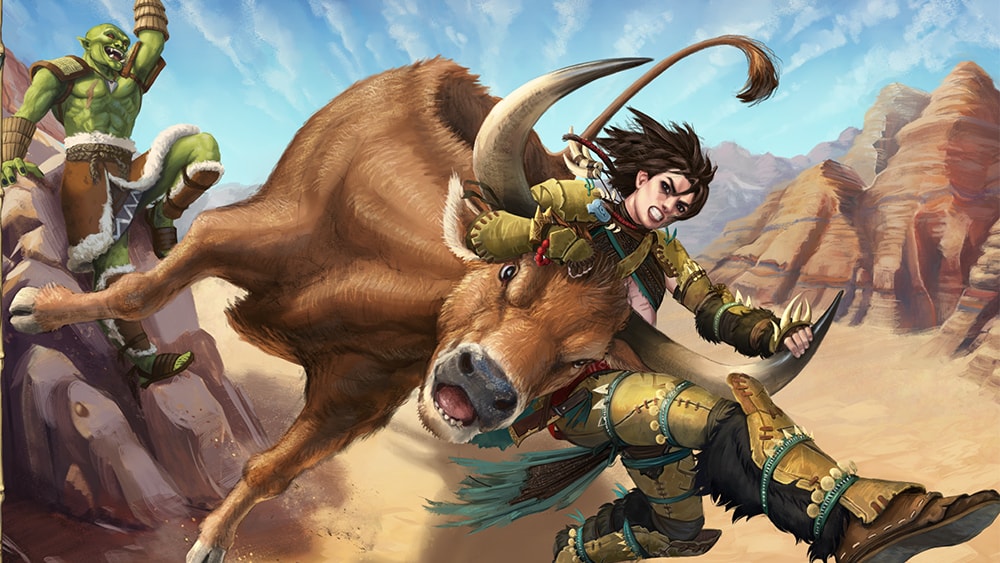


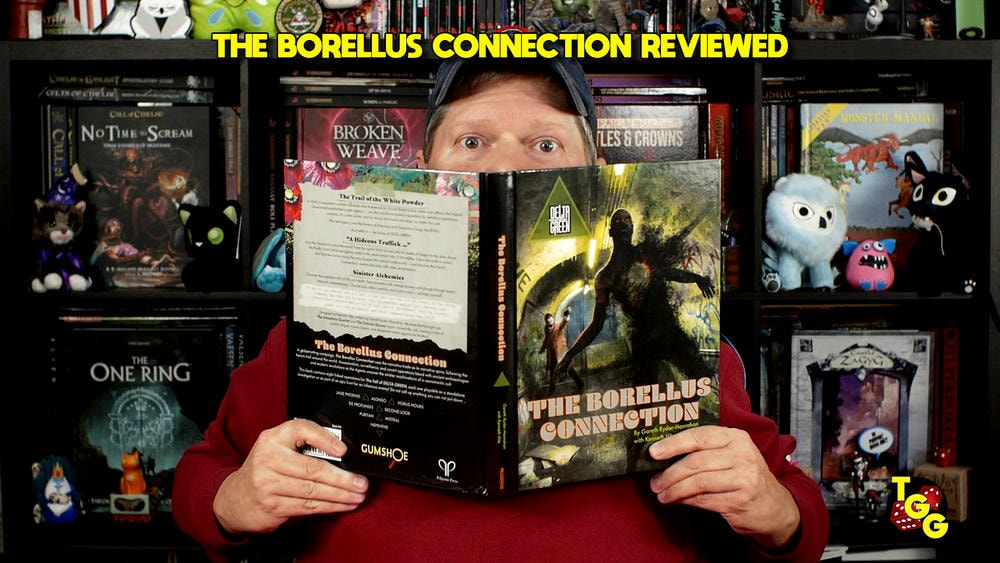




This sounds like a good system for anyone wanting to get into WWII gaming, without having to fork out for a complete tank company or infantry division. There’s enough mini’s out there to justify a skirmish-level game, and the names Priestley and Cavatore should be enough of an incentive for anyone to purchase this. Plus which, there’s plans to release books detailing the major powers such as Britain, the USA, Germany and Soviet Russia. I know people will compare this to 40K and its associated army books, but that system works. I only hope that more kids will get into historical gaming as a result of these rules.
Just thought I’d throw in my two cents
Bolt Action is my main game at the moment, its not easy tearing FOW players away from their toys ( but heck they can play BA with FOW minis)
I dont play 28mm, so my armies are even cheaper. (1/72 is great )
If you want a deep engaging experience where you can use your BA mins, look to Chain of Command. Much more historically accurate, but a touch more difficult to get your head around.
I would say id want to play BA any day, where as CoC I’d want to be in the right brain space.